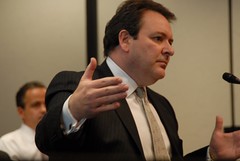
in creating a people-friendly city.
(Photos © J. Maus)
In America, there are many unseen barriers to creating a more human-friendly transportation system. Many of them reside in national engineering manuals that were created — and continue to be “updated” — by auto-centric engineers. Other barriers are entrenched in policies and processes at those familiar bastions of the status quo; state-level Departments of Transportation.
Among the many powerful transportation planning tools that the Oregon DOT holds jurisdiction over is setting speed limits on city streets. It should go without saying how vital speed limits are in creating a bike and pedestrian-friendly city. High-speed, arterial streets — especially through residential areas, where even a 35 mph speed limit feels unsafe — are often the location of very serious collisions.
So what happens when planners and engineers at the City of Portland want to lower a speed limit to make a street safer? The bureaucracy kicks in and ODOT holds all the cards.
As Portland works to create a network of streets that are more friendly to people who walk and bike, one of the key ingredients they’ll need to use is to bring down speed limits. Unfortunately, many local projects have been delayed (bikeway improvements on N. Rosa Parks Way to name one) because of the process the City of Portland must go through in order to alter a speed limit.
Mayor Sam Adams believed that having local oversight of speed limits was important enough to include in his first 100 days to-do list. Adams had promised to “lobby for a bill giving cities jurisdiction over speed limits.” He didn’t do that, but what Adams did do was to draft a letter about the issue to the director of ODOT, Matt Garrett.
In the letter, dated May 19th, Adams wrote that he wants to work with Garrett to make the current speed limit regulation process (which he stated is “problematic” for the City), “safer, more efficient, and more cost-effective.”
Here’s how Adams lays out the problem:
Currently, as laid out in statute and Oregon Administrative Rules, in order to alter the speed limits on streets within city limits, the City of Portland must go through a sometimes lengthy process to determine the appropriate speed limit for every individual street. While the end result could often be predetermined by previously approved speed limits of streets that share the same fundamental traits, the City is required to request a new study for each street segment and the State is then required to conduct duplicative studies for every request. We would like to streamline this process.
Adams points out that the current speed limits are set in an “ad-hoc” fashion, often in response to citizen complaints. This, says Adams, creates “problems in terms of city planning as well as enforcement, and the inconsistencies create confusion among drivers, which can lead to a greater degree of speed violation.”
To remedy the situation, Adams suggests a pilot project that would allow Portland greater flexibility in setting local speed limits.
At this point, it’s just a letter, but the impact of speed limit policy on creating a bike-friendly city cannot be understated. We hope ODOT director Garrett will take heed of the letter and the suggestions. Portland has a very bike-sensitive regional director in Jason Tell, and a Portland pilot project sounds like a great first step.


